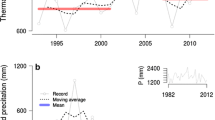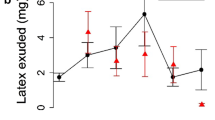Summary
The effects of spring grazing by sheep and of natural levels of insect herbivory were studied in 1985 on a limestone field abandoned from arable land for four years. A split-plot design was adopted in which paddocks, arranged in Latin squares, were either left ungrazed or heavily grazed by sheep for ten days in April. Within each paddock plots were either sprayed regularly with Malathion-60 or untreated.
Natural levels of insect herbivory, compared to the reduced levels in insecticide-treated plots, had effects of similar magnitude to those from the short burst of spring grazing. Many attributes of the grazed/insecticide-treated sward were either increased or decreased by a factor of two within a season. Both types of herbivore caused changes in the direction of plant succession as well as in its rate. Effects on early successional species were large and similar when caused by either type of herbivore. Effects on later successional species were often smaller, but also showed differences in the action of the two herbivore types, as did effects on sward height, species richness and total cover. The effects of sheep and insect herbivory were not always additive or in the same direction.
The results suggest that manipulations of both mammal and insect herbivores may be powerful tools for directing changes in plant community composition.
Similar content being viewed by others
References
Amman GD (1977) The role of the mountain pine beetle in lodgepole pine ecosystems: impact on succession. In Matson WJ (ed) The role of arthropods in forest ecosystems. Springer, Berlin Heidelberg New York, pp 3–18
Baltensweiler W, Benz G, Boney F, Delucchi V (1977) Dynamics of larch bud moth populations. Ann Rev Ento 22:79–100
Bess HA, Spurr SH, Littlefield EW (1947) Forest site conditions and the gypsy moth. Harvard Forestry Bulletin no. 22, Harvard University
Brown VK (1982) The phytophagous insect community and its impact on early successional habitats. In: Visser JM, Minks AK (eds) Proceedings of the 5th international symposium on insect-plant relations, Wageningen, 1982. Pudoc, Wageningen pp 205–213
Brown VK (1984) The ecology of secondary succession: insect-plant relationships. Bioscience 34:710–716
Brown VK (1985) Insect herbivores and succession. Oikos 44:17–22
Charles AH, Hagger RJ (eds) (1979) Changes in sward composition and productivity. British Grassland Society, Hurley, UK
Duffey E, Morris MG, Sheail J, Ward LK, Wells DA, Wells TCE (1974) Grassland ecology and wildlife management. Chapman and Hall, London
Gibson CWD, Dawkins HC, Brown VK, Jepsen M (1987) Spring grazing by sheep: effects on seasonal changes during early old-field succession. Vegetatio (in press)
Grant SA, Suckling DE, Smith HK, Torvell TD, Forbes DA, Hodgson J (1985) Comparative studies of diet selection by shepp and cattle: the hill grasslands. J Ecol 73:987–1004
Hewett DG (1985) Grazing and mowing as management tools on dunes. Vegetatio 62:441–447
Jones MG (1933) Grassland management and its influence on the sward. Empire j exper agricult 1:43–57, 122–128, 223–234, 361–367
McBrien H, Harmsen R, Crowder A (1983) A case of insect grazing affecting plant succession. Ecology 64:1035–1039
Ratcliffe DA (ed) (1977) A nature conservation review. University Press, Cambridge
Smith A (1979) Changes in botanical composition and yield in a long-term experiment. In: Charles AH, Hagger RJ (eds) Changes in sward composition and productivity. British Grassland Society, Hurley, UK pp 69–75
Stinson CSA (1983) Effects of insect herbivores on early successional habitats. Unpublished Ph. D thesis, University of London
Wells TCE (1969) Botanical aspects of conservation management of chalk grasslands. Biol Conserv 2:36–44
Author information
Authors and Affiliations
Rights and permissions
About this article
Cite this article
Gibson, C.W.D., Brown, V.K. & Jepsen, M. Relationships between the effects of insect herbivory and sheep grazing on seasonal changes in an early successional plant community. Oecologia 71, 245–253 (1987). https://doi.org/10.1007/BF00377291
Received:
Issue Date:
DOI: https://doi.org/10.1007/BF00377291




